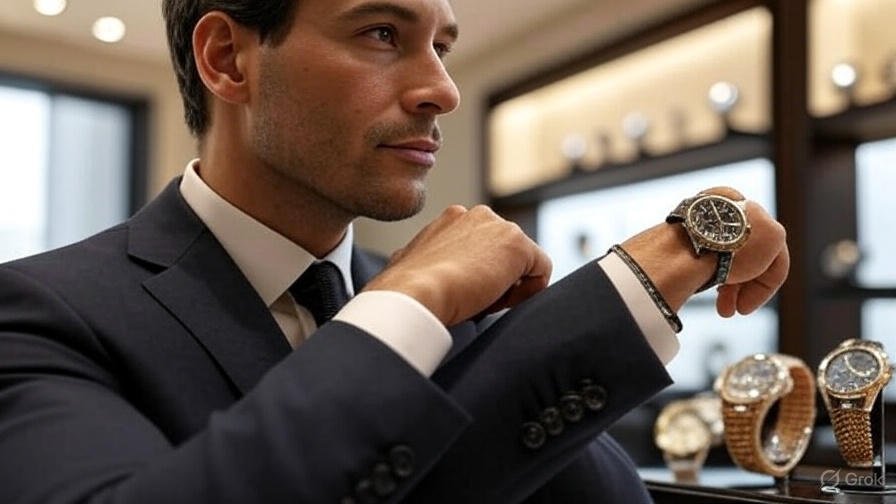The Rise of Counterfeit Timepieces
In recent years, the luxury watch industry has faced a significant challenge: the proliferation of replica watches. These counterfeit timepieces, designed to mimic high-end brands like Rolex, Patek Philippe, and Audemars Piguet, have flooded online marketplaces, creating a complex issue for manufacturers, retailers, and consumers alike. Industry experts report that the global market for counterfeit watches is now worth billions, with estimates suggesting it accounts for nearly 10% of the luxury watch trade.
The allure of replica watches lies in their affordability. While an authentic Rolex Submariner may cost upwards of $10,000, a high-quality counterfeit can be purchased for as little as $200. Advances in manufacturing technology have made it increasingly difficult for the untrained eye to distinguish between genuine and fake timepieces, further fueling their popularity.
Technological Advancements in Counterfeiting
Modern replica watches are no longer the poorly crafted imitations of decades past. Today’s counterfeits often feature precise movements, high-quality materials, and meticulous attention to detail. Some even replicate the weight and feel of authentic luxury watches, making detection a challenge without expert scrutiny. According to a recent report by the International Watchmakers Association, some counterfeiters have begun using 3D printing and advanced laser engraving to mimic brand-specific details, such as serial numbers and logos.
“The sophistication of these replicas is staggering,” says Michael Laurent, a watch authentication expert based in Geneva. “Some fakes are so convincing that even seasoned collectors have been fooled. It’s a cat-and-mouse game between manufacturers and counterfeiters.”
Impact on the Luxury Watch Industry
The influx of counterfeit timepieces poses a significant threat to the luxury watch industry. Major brands report substantial revenue losses due to the sale of replicas, which undermine their exclusivity and brand value. In 2024, Swiss watchmakers collectively lost an estimated $2.5 billion to counterfeit sales, according to the Federation of the Swiss Watch Industry. This figure represents not only lost sales but also the cost of legal battles and anti-counterfeiting measures.
Beyond financial losses, replicas erode consumer trust. Buyers who unknowingly purchase a counterfeit watch may feel betrayed, damaging their perception of the brand. “When someone buys a fake thinking it’s real, and it breaks or is exposed as a counterfeit, they often blame the brand itself,” says Emily Chen, a luxury retail analyst. “This can have long-term consequences for customer loyalty.”
Legal and Ethical Challenges
Combating the replica watch trade is a daunting task. Counterfeiters often operate in jurisdictions with lax intellectual property laws, making prosecution difficult. Online marketplaces, while cooperating with brands to remove listings, struggle to keep pace with the volume of counterfeit goods. In 2024, a major e-commerce platform reported removing over 500,000 listings for counterfeit watches, yet new listings continue to appear daily.
Ethically, the replica watch market raises questions about consumer behavior. Some argue that purchasing counterfeits is a victimless crime, providing access to luxury aesthetics without the exorbitant price tag. Others contend that it fuels organized crime and exploits workers in unregulated factories. “Many of these operations are linked to larger criminal networks,” says Laurent. “Buying a fake watch might seem harmless, but it often supports unethical practices.”
Consumer Awareness and Protection
As the replica watch market grows, so does the need for consumer education. Experts urge buyers to purchase only from authorized dealers or reputable resellers to avoid falling victim to scams. Key red flags include prices that seem too good to be true, vague product descriptions, and sellers who refuse to provide detailed photos or documentation.
Authentication services have also emerged as a critical tool in the fight against counterfeits. Companies like WatchGuard and AuthentiCheck offer professional verification, using advanced techniques such as micro-engraving analysis and movement inspection. “If you’re spending thousands on a watch, it’s worth the extra step to have it authenticated,” advises Chen.
The Role of Technology in Combating Fakes
Luxury watch brands are fighting back with innovative anti-counterfeiting measures. Some manufacturers have begun embedding microchips or blockchain-based certificates of authenticity in their timepieces, allowing buyers to verify their purchase through a secure database. Others are investing in proprietary materials and manufacturing techniques that are difficult to replicate.
For example, a leading Swiss brand recently introduced a new sapphire crystal with a unique refractive index that is nearly impossible to duplicate. Such advancements aim to stay one step ahead of counterfeiters, though experts acknowledge that the battle is ongoing. “As soon as we develop a new security feature, counterfeiters start working on ways to mimic it,” says Laurent.
The Future of the Luxury Watch Market
Looking ahead, the luxury watch industry faces a pivotal moment. While replicas continue to challenge brand integrity, they also highlight the enduring appeal of luxury timepieces. For many consumers, owning a high-end watch is about more than telling time—it’s a statement of craftsmanship, heritage, and status. As such, brands are doubling down on storytelling and exclusivity to differentiate themselves from fakes.
Industry leaders are also exploring new ways to engage younger consumers, who are increasingly targeted by replica sellers. Limited-edition collaborations, sustainable manufacturing, and immersive brand experiences are becoming key strategies to maintain loyalty in a competitive market. “The future lies in creating value that can’t be replicated,” says Chen. “It’s about the story, the craftsmanship, and the emotional connection.”
Conclusion
The rise of replica watches represents a complex challenge for the luxury watch industry, blending technological, legal, and ethical considerations. While counterfeiters continue to innovate, so too do brands, leveraging advanced technology and consumer education to protect their legacy. For now, the battle between authenticity and imitation rages on, with consumers caught in the crossfire. As the market evolves, one thing remains clear: the value of a genuine luxury watch lies not just in its mechanics but in the story it tells.
More information please visit TNAFLIX.
